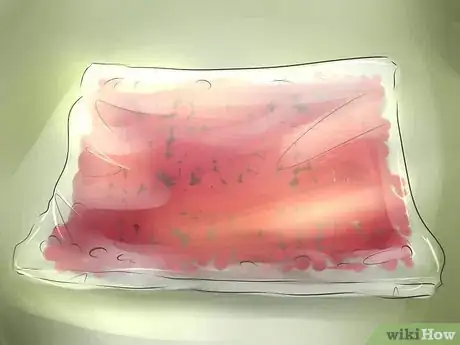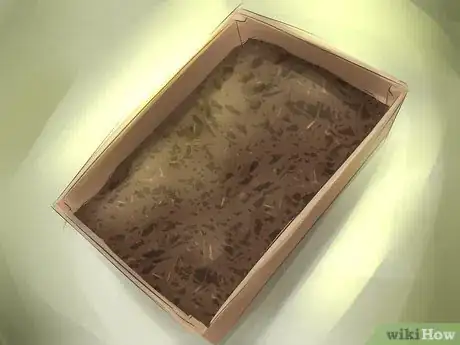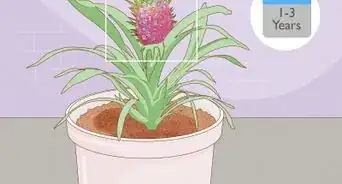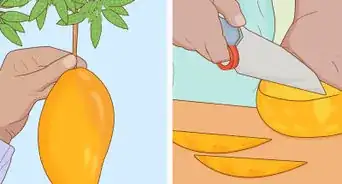This article was co-authored by Andrew Carberry, MPH. Andrew Carberry is a Food Systems Expert and the Senior Program Associate at the Wallace Centere at Winrock International in Little Rock, Arkansas. He has worked in food systems since 2008 and has experience working on farm-to-school projects, food safety programs, and working with local and state coalitions in Arkansas. He is a graduate of the College of William and Mary and holds a Masters degree in public health and nutrition from the University of Tennessee.
There are 13 references cited in this article, which can be found at the bottom of the page.
wikiHow marks an article as reader-approved once it receives enough positive feedback. In this case, 81% of readers who voted found the article helpful, earning it our reader-approved status.
This article has been viewed 138,091 times.
Cranberries are a tart, red berry most commonly used in a variety of sauces, pies and juices. They are also a popular addition to salads and are eaten in dried form as a snack. In recent years, cranberries have also become well-known for their healing qualities, due in large part to their high concentration of vitamin C and antioxidants. Most commonly grown commercially, cranberries can also be grown at home. Start with Step 1 below to learn how to grow cranberries.
Steps
Planting the Cranberries
-
1Choose a variety of cranberry. There are several varieties of cranberry plants that can be used in home growing. The variety you choose will depend on what you intend to use the berries for.[1]
- Howes cranberries are small, red berries native to Massachusetts. They are easy to grow and will stay fresh for a long time after harvesting, if stored correctly.
- Stevens cranberries are a hybrid variety of cranberry designed for productivity and disease resistance. They are large and bright red in color.
- Two more varieties are Ben Lear (large, burgundy-colored berries) and Early Black (small, deep red berries). However, these varieties are not recommended for first time growers as they are more difficult to care for and are more prone to disease and insect infestation than the other varieties.
-
2Plant at the right time of year. Cranberries are best grown in cooler climates. Consult a USDA plant hardiness zone map.[2] Cranberries should be grown between zones two and five. This includes much of the northern and Midwestern United States.[3] Cranberries can be planted at various times throughout the year, depending on the age of the plant.
- Cuttings and seedlings can be planted throughout autumn, from October to early November. They can also be planted in springtime, from the middle of April to the end of May.[4]
- 3 year old rooted plants -- which are still actively growing -- can sometimes be planted in summer, provided they are purchased in pots.
Advertisement -
3Prepare the soil. When it comes to soil, cranberry plants have unique requirements -- they need soil with a low pH value and a high level of organic matter. As a result, it is often necessary to replace your existing soil instead of trying to alter it.
- The average size for a cranberry plot is 4 foot (1.2 m) by 8 foot (2.4 m). However, if you are only growing a single plant, a 2 foot (0.6 m) by 2 foot (0.6 m) square will do just fine.
- Dig out the existing soil in the cranberry plot, to a depth of 6 to 8 inches (15.2 to 20.3 cm). Fill the plot in with peat moss, then mix in 1/2 pound of bone meal and 1 pound of blood meal.
- Optionally, you can add 1 cup of epsom salts and 1 pound of rock phosphate as well. (These quantities are for a 32 sq. foot plot, so adjust accordingly).
- Before planting, wet the soil thoroughly (but do not saturate it). You can do this by misting the plot with the garden hose, mixing the soil periodically to encourage absorption.[5]
-
4Plant the cuttings or seedlings. Cranberry plants are not grown from seeds, but from one year old cuttings or three year old seedlings.[6]
- It's important to be aware that cranberry plants do not start to produce fruit until their third or fourth year -- so whether you choose to plant cuttings or seedlings will depend on how quickly you want fruit.
- If you choose to plant cranberry cuttings, plant them in the prepared wet soil, leaving approximately one foot of space between each plant. The root ball of each plant should be about 2 inches (5.1 cm) below the surface of the soil.
- If you choose to plant 3 year old seedlings, leave approximately three feet of space between each plant.
-
5Alternatively, grow the cranberries in a container. Cranberry plants grow best in a garden plot, where they have plenty of space to spread their runners. However, it is also possible to grow a single plant in a large pot. Choose a pot that is at least twice the size of the plant's root ball.[7]
- Fill the pot with peat moss and plant a three year old seedling. Allow the plant to develop runners inside the pot (as these will take root and form fruit-bearing uprights), but trim any that extend beyond it. You can also fertilize the soil with low-nitrogen fertilizer, as this will limit the growth of runners.
- Potted cranberry plants will need to be replaced every couple of years (unlike those in plots which sustain themselves indefinitely).
Caring for the Cranberry Plants
-
1Be vigilant about weeds. Cranberry plants do not compete well against weeds, so it's very important to weed the bed regularly, particularly during the first year. Luckily, the peat moss used in the cranberry plot will inhibit the growth of many common garden weeds.
-
2Keep the cranberry plants well-watered. During the first year (and beyond) cranberry plants will need constant watering to keep the soil. If the roots dry out, the plants will die.[8]
- It is a common misconception that cranberry plants need to be saturated or submerged in water during growing. Although the soil should always be wet (or at least damp) to the touch, it shouldn't be saturated with water.
- Too much water can slow down root growth and prevent the roots from reaching the necessary depth.
-
3Fertilize the soil. Soon, your cranberry plants will start to put out out runners that grow along the ground. The runners should grow until they fill and cover the bed. If they do not, you can fertilize your cranberry bed with a high-nitrogen fertilizer. Only use fertilizer if runners are struggling to grow; too much high-nitrogen fertilizer may cause overwhelming growth.[9]
- If fertilizing in the first year, fertilize the soil three times -- once at the beginning of growth, once when the flowers bud and once when the berries start forming.
- In order to contain the spread of runners within the cranberry plot, you may want to line the perimeter of the bed with some wooden or plastic edging.
- After the first year, you'll need to cut off the nitrogen supply to the runners -- this will encourage them to stop spreading so they will take root and form uprights instead. Use a non-nitrogen fertilizer from the second year onwards.
- At the start of the second year (and every couple of years after that) you will need to cover the soil with a thin (1/2 inch) layer of sand. This helps to root the runners and prevent weeds.
-
4Control pests and disease. Cranberry plants are susceptible to certain pests and diseases, but these are relatively easy to deal with, provided you know what to look for.[10]
- Cranberry fruit-worm is a common problem, where grey moths lay their eggs inside the berries themselves. If you spot grey moths around your cranberry plants, you will need to spray the plot with insecticides to kill the eggs.
- If you do not catch fruitworm on time, the eggs will hatch and the worms will eat the cranberries from the inside out. When this happens, the infested berries will turn red before they ripen. You can deal with this by picking off the prematurely red berries (in addition to the surrounding fruit) and disposing of them.
- Two other common diseases are red spot (where bright red spots develop on the leaves of the plant) and berry fruit rot. The treatment for both of these diseases is the same -- spray the cranberry plants with an organic, copper-based fungicide between late June and early August, according to the instructions on the label.[5]
-
5Prune the runners from the third year of growth. From the third year of growth onwards, you will need to prune the cranberry plants each spring to control the runners and encourage uprights.[11]
- You can do this by combing the cranberry plot with a landscape rake, until all of the runners are going in the same direction. This makes it easier to identify the longest runners and cut them back. Do not prune the existing uprights.
- As time goes on, your cranberry plants may begin to spread beyond the bounds of the original plot. If this happens, you can prune each of the plants back in the springtime, until there is only two inches of growth above the soil line. The cranberry plants will not produce fruit that year, but normal production will resume the following year.
Harvesting the Cranberries
-
1Harvest the cranberries. If you planted three year old seedlings, your cranberry plant may by producing fruit by the following autumn. But if you planted one year old cuttings, you may need to wait three or four years before your plant produces fruit.[12]
- Once your plant is producing fruit, you can harvest the berries in September and October of each year. When the berries are ripe they will be be bright or dark red in color (depending on the variety) and the seeds inside will be brown.
- Although commercial growers harvest cranberries by flooding the fields in order to make the cranberries float (and therefore easier to collect), this is not necessary for home growers. The cranberries can simply be picked off the plants by hand.
- It is important that you harvest all of the fruit before the first hard winter frost, as cranberries cannot withstand temperatures below 30 °F (−1 °C).
-
2Store the fruit. Once harvested, cranberries will stay fresh for up to two months when stored in an airtight container in the refrigerator -- this is much longer than most fruits.[13]
- Cooked cranberries (or cranberry sauce) will last in the refrigerator for up to a month, while dried cranberries (which have a similar texture to raisins) will keep for up to a year.
-
3Protect the cranberry plants over the winter. It is important to protect your cranberry plants over the winter months to prevent them from freezing and drying out. You can do this by covering the cranberry plot with an opaque white plastic mulch before winter sets in.[14]
- You can uncover the cranberry plants in springtime (around April 1st) but you should be prepared to cover them on any night when frost is expected, as a frosty night could kill any new shoots and prevent fruit from growing that year.
- Never cover your cranberry plants with clear or black plastic, however, as this can raise the temperature of the bed and potentially kill the plants.
- Do not cover the plants with pine needles or leaves, as these might reduce the number of flowers and fruits that the plant produces the next year.
Expert Q&A
Did you know you can get expert answers for this article?
Unlock expert answers by supporting wikiHow
-
QuestionCan I plant a cranberry plant that I have dug up?
 Andrew Carberry, MPHAndrew Carberry is a Food Systems Expert and the Senior Program Associate at the Wallace Centere at Winrock International in Little Rock, Arkansas. He has worked in food systems since 2008 and has experience working on farm-to-school projects, food safety programs, and working with local and state coalitions in Arkansas. He is a graduate of the College of William and Mary and holds a Masters degree in public health and nutrition from the University of Tennessee.
Andrew Carberry, MPHAndrew Carberry is a Food Systems Expert and the Senior Program Associate at the Wallace Centere at Winrock International in Little Rock, Arkansas. He has worked in food systems since 2008 and has experience working on farm-to-school projects, food safety programs, and working with local and state coalitions in Arkansas. He is a graduate of the College of William and Mary and holds a Masters degree in public health and nutrition from the University of Tennessee.
Food Systems Expert
-
QuestionWhy are cranberries grown in a bog?
 Andrew Carberry, MPHAndrew Carberry is a Food Systems Expert and the Senior Program Associate at the Wallace Centere at Winrock International in Little Rock, Arkansas. He has worked in food systems since 2008 and has experience working on farm-to-school projects, food safety programs, and working with local and state coalitions in Arkansas. He is a graduate of the College of William and Mary and holds a Masters degree in public health and nutrition from the University of Tennessee.
Andrew Carberry, MPHAndrew Carberry is a Food Systems Expert and the Senior Program Associate at the Wallace Centere at Winrock International in Little Rock, Arkansas. He has worked in food systems since 2008 and has experience working on farm-to-school projects, food safety programs, and working with local and state coalitions in Arkansas. He is a graduate of the College of William and Mary and holds a Masters degree in public health and nutrition from the University of Tennessee.
Food Systems Expert
-
QuestionCan I use tap water to water my cranberries, or would cooled boiled tap water be better for them?
 Community AnswerYou should avoid watering plants with water saturated with chemicals, such as fluoride and chlorine.; also, boiling alters the oxygen in the water, which plants need to survive. The best water is natural spring water or distilled water. You should also include the proper nutrients for either lush greenery or profuse bloom.
Community AnswerYou should avoid watering plants with water saturated with chemicals, such as fluoride and chlorine.; also, boiling alters the oxygen in the water, which plants need to survive. The best water is natural spring water or distilled water. You should also include the proper nutrients for either lush greenery or profuse bloom.
Things You'll Need
- Shovel
- Peat moss
- Cranberry plants (either 1- or 3-year old)
- Blood meal
- Bone meal
References
- ↑ https://www.webmd.com/food-recipes/5-winter-superfoods-cranberries-preparation-varieties
- ↑ https://planthardiness.ars.usda.gov/PHZMWeb/
- ↑ https://plants.usda.gov/core/profile?symbol=VAMA
- ↑ https://practicalselfreliance.com/how-to-grow-cranberries/
- ↑ 5.05.1http://www.gardeningblog.net/how-to-grow/cranberries/
- ↑ http://www.umass.edu/cranberry/downloads/Homeowner's%20fact%20sheet%202010.pdf
- ↑ https://plantinstructions.com/fruit/how-to-grow-cranberries-in-pots/
- ↑ https://www.cranberries.org/how-cranberries-grow/water-use
- ↑ https://www.cranberries.org/sites/default/files/uploads/pdf/soil_fertility.pdf
- ↑ https://plantvillage.psu.edu/topics/cranberry/infos
- ↑ http://www.umass.edu/cranberry/downloads/2010%20BMP/BMP%20Pruning%20(2010).pdf
- ↑ https://www.cranberries.org/how-cranberries-grow/fall
- ↑ https://www.epicurious.com/ingredients/how-to-buy-and-store-fresh-cranberries-article
- ↑ https://s3.wp.wsu.edu/uploads/sites/2166/2018/01/Fall-to-Winter-Cranberry-Plant-Hardiness.pdf
About This Article
To grow cranberries, plant your seeds or cuttings in soil with a low pH and high level of organic matter. You can grow them in a pot or garden bed, but be sure to dampen the soil before you plant the seeds. During the first year of growing, water the cranberry plant every day to keep the soil wet, and apply fertilizer 3 times in the year. After the first year, continue watering the plant every day, but stop adding fertilizer to the soil and be sure to prune any runners that grow along the ground. Harvest the cranberries in the autumn of the third year and enjoy. If you want to learn how to store the cranberries after you harvest in, keep reading the article!











































































